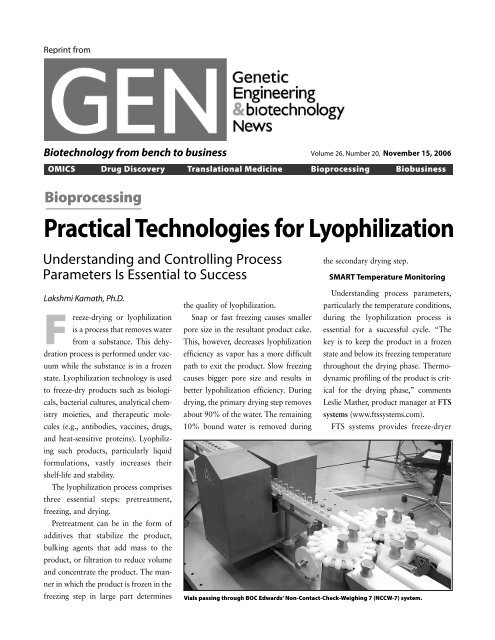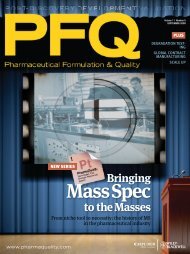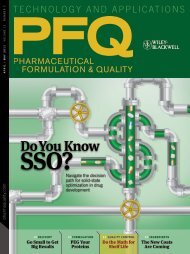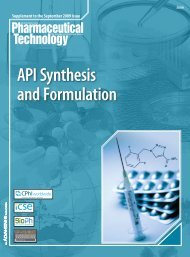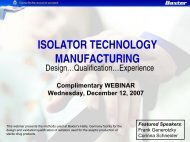Practical Technologies for Lyophilization - Sterile Parenteral Drug ...
Practical Technologies for Lyophilization - Sterile Parenteral Drug ...
Practical Technologies for Lyophilization - Sterile Parenteral Drug ...
Create successful ePaper yourself
Turn your PDF publications into a flip-book with our unique Google optimized e-Paper software.
Reprint from<br />
Biotechnology from bench to business<br />
Lakshmi Kamath, Ph.D.<br />
F<br />
reeze-drying or lyophilization<br />
is a process that removes water<br />
from a substance. This dehydration<br />
process is per<strong>for</strong>med under vacuum<br />
while the substance is in a frozen<br />
state. <strong>Lyophilization</strong> technology is used<br />
to freeze-dry products such as biologicals,<br />
bacterial cultures, analytical chemistry<br />
moieties, and therapeutic molecules<br />
(e.g., antibodies, vaccines, drugs,<br />
and heat-sensitive proteins). Lyophilizing<br />
such products, particularly liquid<br />
<strong>for</strong>mulations, vastly increases their<br />
shelf-life and stability.<br />
The lyophilization process comprises<br />
three essential steps: pretreatment,<br />
freezing, and drying.<br />
Pretreatment can be in the <strong>for</strong>m of<br />
additives that stabilize the product,<br />
bulking agents that add mass to the<br />
product, or filtration to reduce volume<br />
and concentrate the product. The manner<br />
in which the product is frozen in the<br />
freezing step in large part determines<br />
the quality of lyophilization.<br />
Snap or fast freezing causes smaller<br />
pore size in the resultant product cake.<br />
This, however, decreases lyophilization<br />
efficiency as vapor has a more difficult<br />
path to exit the product. Slow freezing<br />
causes bigger pore size and results in<br />
better lypohilization efficiency. During<br />
drying, the primary drying step removes<br />
about 90% of the water. The remaining<br />
10% bound water is removed during<br />
Volume 26, Number 20, November 15, 2006<br />
OMICS <strong>Drug</strong> Discovery Translational Medicine Bioprocessing Biobusiness<br />
Bioprocessing<br />
<strong>Practical</strong> <strong>Technologies</strong> <strong>for</strong> <strong>Lyophilization</strong><br />
Understanding and Controlling Process<br />
Parameters Is Essential to Success<br />
the secondary drying step.<br />
SMART Temperature Monitoring<br />
Understanding process parameters,<br />
particularly the temperature conditions,<br />
during the lyophilization process is<br />
essential <strong>for</strong> a successful cycle. “The<br />
key is to keep the product in a frozen<br />
state and below its freezing temperature<br />
throughout the drying phase. Thermodynamic<br />
profiling of the product is critical<br />
<strong>for</strong> the drying phase,” comments<br />
Leslie Mather, product manager at FTS<br />
systems (www.ftssystems.com).<br />
FTS systems provides freeze-dryer<br />
Vials passing through BOC Edwards’ Non-Contact-Check-Weighing 7 (NCCW-7) system.
equipment to pharmaceutical and<br />
biotechnology companies <strong>for</strong> their <strong>for</strong>mulations<br />
work and process development<br />
of parenteral products. “Our<br />
Smart Freeze-Dryer calculates product<br />
temperature and makes adjustments in<br />
the process to keep product frozen<br />
throughout the cycle. Smart freezedrying<br />
technology uses the data from<br />
manometric pressure rise measurement<br />
in its proprietary algorithms to accurately<br />
calculate product temperature at<br />
the ice surface interface of the product.<br />
“Smart Freeze Dryer equipment has<br />
an isolation valve between the product<br />
and condenser chamber. This valve closes<br />
<strong>for</strong> 25 seconds and the system measures<br />
pressure at the valve junction; 250<br />
pressure readings are used to calculate<br />
product temperature. SMART then<br />
makes automatic adjustments in chamber<br />
pressure and shelf setpoint temperature<br />
to quickly bring the product temperature<br />
to a safety margin just below<br />
its collapse temperature. Since freezedrying<br />
cycles can be long, ranging anywhere<br />
from six hours to one week, the<br />
Smart system can save money by eliminating<br />
the trial-and-error approach to<br />
cycle design,” explains Mather.<br />
Process Analytical Technology<br />
PAT is based on the premise that quality<br />
assurance should be built-in or<br />
designed as part of the product. It<br />
emphasizes a process-driven approach<br />
vs. the more traditional data-validated<br />
approach. “The goal of PAT is to specify,<br />
monitor, and control processes to consistently<br />
ensure a pre-defined product quality,”<br />
states Jos Corver, senior scientist at<br />
BOC Edwards (www.bocedwards.com).<br />
PAT is emphasized by FDA <strong>for</strong> two<br />
reasons: the old-fashioned time-consuming<br />
data-oriented approach did not guarantee<br />
a flawless process or product quality<br />
and the release of new medical drugs<br />
was delayed by the time-consuming<br />
review of required data, which motivated<br />
the FDA to promote new technologies<br />
that increase the quality of monitoring<br />
data, leading to better process control.<br />
“PAT can be quite powerful as understanding<br />
the science behind a given technology<br />
is its main focus. Knowing what<br />
you are doing, understanding important<br />
parameters, and applying science to<br />
control and improve process can highly<br />
improve product quality,” says Corver.<br />
NMR-based Noncontact<br />
Weighing Technology<br />
Devising a well-controlled and predictable<br />
process requires accurate measurement<br />
of critical parameters, one of<br />
these being IPC (in-process control) of the<br />
filling system. Traditional balances rely on<br />
data derived from sampling vials taken<br />
out from the actual process and are subject<br />
to vagaries such as vibration, air-flow,<br />
and pressure fluctuations.<br />
BOC Edwards has devised a noninvasive<br />
NMR-based, in-line, noncontact<br />
check-weighing (NCCW) technology.<br />
This system determines the weight of<br />
the contents of a vial with a single measurement,<br />
without taking the vial out of<br />
the transport system and without making<br />
physical contact with the vial. Since<br />
the response to an electromagnetic pulse<br />
is linearly proportional to the amount of<br />
product, a relatively simple calibration<br />
procedure is sufficient to apply this technology<br />
as a balance.<br />
“It is critical that the amount of product<br />
in pharmaceutical drug vials is guaranteed<br />
within the label claim. Measurement<br />
of the contents of each individual<br />
vial is there<strong>for</strong>e an important aspect.<br />
Vials are typically overfilled to meet the<br />
stated claim. This NMR technique can<br />
be applied to liquid and solids. Having a<br />
system that gives feedback to filling stations<br />
at 100% rate allows <strong>for</strong> good<br />
process control. One can there<strong>for</strong>e produce<br />
at lower volume vials due to the<br />
narrower band fill and accuracy of the<br />
technology. Wastage due to overfilling<br />
can be avoided resulting in time and<br />
cost savings,” says Dr. Corver.<br />
Biopharma Technology (BTL; www.<br />
lyophilizationtechnology.com) markets a<br />
Lyostat 2 freeze-drying microscope and a<br />
Lyotherm 2 thermal analyzer. The Lyostat<br />
2 Freeze Drying Microscope System<br />
enables identification of collapse and<br />
eutectic (freezing point) temperatures. In<br />
the Lyostat 2 system, an in-built stage<br />
chamber acts as a micro freeze-dryer. A<br />
small product sample is loaded onto a temperature-controlled<br />
block and subjected to<br />
freezing at a selected rate and observed<br />
while drying at a range of temperatures in<br />
order to determine its critical temperature(s).<br />
This process can be viewed in realtime<br />
either through the microscope or on a<br />
PC with image-capture software.<br />
Microscope and Thermal<br />
Impedance<br />
The Lyotherm 2 thermal analyzer<br />
enables one to per<strong>for</strong>m differential thermal<br />
analysis (DTA) and electrical impedance<br />
measurement at the same time. This<br />
is an alternative low-cost technology<br />
compared to the Differential Scanning<br />
Calorimeter (DSC). The DTA allows<br />
determination of glass transition (Tg),<br />
eutectic (Teu) temperatures and crystallization<br />
events, while the data obtained<br />
from impedance analysis (Zsinϕ)—a<br />
method that is based on conventional<br />
resistance technology (as used in socalled<br />
eutectic monitors), but that has<br />
been demonstrated to be more sensitive<br />
to changes in frozen solutes—can be correlated<br />
to critical mobility-related events<br />
occurring in the frozen material.<br />
The in<strong>for</strong>mation gained from Lyostat<br />
2 and Lyotherm 2 enables <strong>for</strong>mulations<br />
to be refined according to behavior and<br />
November 15, 2006 genengnews.com Genetic Engineering & Biotechnology News
lyophilization parameters to be selected<br />
on a rational and product-specific basis.<br />
Importance of Formulation<br />
“Formulation composition is important<br />
when devising a product lyophilization<br />
process. For example, bulking<br />
agents may be added when one wants to<br />
freeze-dry small amounts of potent material,<br />
protective agents are added when<br />
one is dealing with heat-sensitive enzyme,<br />
antibody, or protein to prevent aggregation,<br />
and thermal stabilizers like dextran<br />
or PEG may be added to remedy a situation<br />
where a freeze-drying cycle is protracted<br />
due to the <strong>for</strong>mulation having a<br />
low critical temperature,” explains Kevin<br />
Ward, Ph.D, director of R&D at BTL.<br />
Developing the right <strong>for</strong>mulation<br />
depends on factors such as the final<br />
dosage <strong>for</strong>m of product, the stage of clinical<br />
development, and the desired product<br />
concentration. For example, many<br />
antibody therapeutics require high product<br />
concentration to demonstrate efficacy<br />
after subcutaneous (SC) or intra-muscular<br />
(IM) administration. In such cases,<br />
freeze-drying may be useful not only <strong>for</strong><br />
maintenance of product stability, but also<br />
to facilitate concentration of product via<br />
reconstitution in the small volumes<br />
(≤2mL) required <strong>for</strong> SC and IM injection.<br />
KBI BioPharma (www.kbibiopharma.com)<br />
adopts a multi-step approach<br />
to <strong>for</strong>mulation development. The company<br />
is a contract development organization<br />
<strong>for</strong> analytical, <strong>for</strong>mulation, and<br />
process development <strong>for</strong> biotherapeutic<br />
proteins. The con<strong>for</strong>mational and thermal<br />
properties of a product are first<br />
characterized using biophysical techniques<br />
such as differential scanning<br />
calorimetry, circular dichroism, FTIR,<br />
and fluorescence spectroscopy.<br />
Statistical design of experiments is<br />
used during pre<strong>for</strong>mulation development<br />
to identify the optimal <strong>for</strong>mulation<br />
conditions (buffer type, pH, ionic<br />
strength, excipients), which result in<br />
chemical and con<strong>for</strong>mational stability<br />
of the product. The final concentrations<br />
of product, bulking agents, and cryoprotectants<br />
are optimized during<br />
freeze-drying cycle development.<br />
“Technology transfer to the manufacturing<br />
facility is a critical element <strong>for</strong> a<br />
successful production run. Development<br />
is usually per<strong>for</strong>med at a smaller scale<br />
using partial product loads, based on<br />
API availability and cost. Differences in<br />
scale as well as freeze-dryer design differences<br />
must be evaluated as part of<br />
tech transfer. Hence, involvement of the<br />
development house with production<br />
facility is imperative <strong>for</strong> successful<br />
process transfer,” states Tim Kelly,<br />
Ph.D., vp of biopharmaceutical development<br />
at KBI BioPharma.<br />
Stopper Selection<br />
Stopper selection, particularly <strong>for</strong> drug<br />
vials, is an important component of the<br />
freeze-drying process. The stoppers<br />
should aid sublimation without much<br />
moisture absorption or migration into<br />
product composition.<br />
“The functional requirements of the<br />
stopper need to be maintained in the context<br />
of product compatibility, process<br />
compatibility, moisture absorption, and<br />
moisture transmission,” comments Fran<br />
DeGrazio, vp of marketing and strategic<br />
business development at West Pharmaceutical<br />
Services (WPS; www.westpharma.com).<br />
West Pharmaceutical Services<br />
markets several lyophilization stoppers<br />
with various treatment options.<br />
“It is critical to choose the right elastomeric<br />
components to prevent stopper<br />
extractables from leaching into the drug<br />
product. WPS improves stopper per<strong>for</strong>mance<br />
by also adding coatings and films<br />
FTS systems’ LyoStar II R&D Freeze-Dryer <strong>for</strong><br />
process development.<br />
to these elastomeric components. Stoppers<br />
sticking to the lyophilization shelf<br />
can be prevented with the appropriate<br />
lubricious coating,” explains DeGrazio.<br />
One of the company’s offerings is<br />
LyoTec Stoppers. These stoppers are<br />
enhanced by Westar RS (ready to sterilize)<br />
or RU (ready to use) processing.<br />
The Westar stoppers receive a pharmaceutical-grade<br />
wash and are certified<br />
<strong>for</strong> pyrogen removal, bioburden, particles,<br />
and silicone.<br />
“Westar RS stoppers are available <strong>for</strong><br />
small volume production so one can use<br />
the same stopper right from lab testing<br />
through clinical trials into production<br />
runs. This takes a lot of variability out<br />
of the process,” says DeGrazio.<br />
The LyoTec stoppers are also available<br />
with B2 or FluroTec ® coating. B2 coating<br />
is polymerized silicone coating that<br />
reduces friction on stoppers as they pass<br />
through the filling lines. This results in<br />
improved movement and line speeds.<br />
FluroTec film coating (made from ethylene-tetrafluoroethylene<br />
copolymer) is<br />
applied to the top and plug portion of<br />
stoppers. It improves compatability<br />
between the drug and closure, and provides<br />
a barrier against potential extracta-<br />
Genetic Engineering & Biotechnology News genengnews.com November 15, 2006
Biopharma Technology’s Lyotherm 2 provides an integrated differential thermal analyzer and an<br />
electrical impedance capability in one instrument. Lyotherm 2 has been designed to measure<br />
glass transition, eutectic melt, and melting temperatures relevant to freeze drying.<br />
bles. The FluroTec coating eliminates the<br />
need <strong>for</strong> silicone oil lubrication thus preventing<br />
particulate contamination.<br />
“A key point to note with respect to<br />
any stopper is that it should be<br />
already dry prior to placement on the<br />
product vial preceding lyophilization.<br />
<strong>Lyophilization</strong> cycles are designed<br />
with drug product characteristics and<br />
not stopper characteristics in mind,”<br />
comments DeGrazio.<br />
Material Science Approach<br />
Baxter Biopharma Solutions (www.<br />
baxterbiopharmasolutions.com) offers<br />
services that support freeze-drying <strong>for</strong>mulation<br />
and process development from<br />
the research and development stage all<br />
the way to commercial production runs<br />
<strong>for</strong> clinical and commercial products. Its<br />
freeze-drying facility in Bloomington,<br />
IN, can handle products of varying<br />
batch sizes and volumes using one or<br />
more of six commercial size and one<br />
clinical size freeze dryers.<br />
From a technology perspective, Baxter<br />
adopts a materials science approach in<br />
developing a freeze-drying process,<br />
according to Steven Nail, Ph.D., senior<br />
research scientist at Baxter. “We per<strong>for</strong>m<br />
a comprehensive thermal analysis, and<br />
freeze-dry microscopic analysis to optimize<br />
process parameters. For freezedried<br />
protein <strong>for</strong>mulations, we have the<br />
capability to interface FTIR with the<br />
freeze-dry microscope to examine secondary<br />
structure of proteins in real-time<br />
during freeze-drying. Currently, Baxter is<br />
the only company that applies<br />
FTIR/freeze-dry microscopy technology<br />
in freeze-drying process development.”<br />
Existing Challenges in<br />
<strong>Lyophilization</strong><br />
While freeze drying is the preferred<br />
method to remove water from a product,<br />
it has its limitations. Biomolecules can be<br />
adversely impacted due to the stresses of<br />
the freezing and/or drying process. “The<br />
challenge is how do we optimize the<br />
freeze-drying process to make a pharmaceutically<br />
acceptable product in a costeffective<br />
manner. Drying operations can<br />
be quite expensive. For example, the cost<br />
of a production freeze dryer can be<br />
greater than $3 million. Because of the<br />
high value of the product produced in a<br />
typical batch of freeze-dried injectable<br />
product, the need <strong>for</strong> redundancy in<br />
refrigeration equipment and vacuumpumping<br />
equipment adds considerably<br />
to the cost,” says Dr. Nail.<br />
Another challenge is achieving the<br />
target moisture content in a specific<br />
product. The last of the solute-bound<br />
residual water in the product is<br />
removed during secondary drying. The<br />
secondary drying process is critical as<br />
not all of the water is in frozen <strong>for</strong>m so<br />
product has to be dried carefully. Overdrying<br />
can result in a less stable product.<br />
“Baxter will soon be acquiring a<br />
process analytical technology capability,<br />
an in-process mass flow meter that<br />
allows precise monitoring of water<br />
removal. This meter will integrate mass<br />
flow rate throughout a freeze-dry cycle,<br />
giving the cumulative mass of water<br />
removed,” explains Dr. Nail.<br />
Design of the correct <strong>for</strong>mulation<br />
remains a challenge. “Customers typically<br />
determine their <strong>for</strong>mulations in<br />
an empirical manner and it can be<br />
exceedingly difficult to convince a<br />
customer to change to a better <strong>for</strong>mulation.<br />
Inappropriately designed <strong>for</strong>mulations<br />
and cycle continue to be a<br />
bane, an issue that FDA is well aware<br />
of,” states Dr. Nail.<br />
Product comparability between<br />
freeze drying and liquid <strong>for</strong>mulations<br />
is another issue. “Clients sometimes<br />
prefer liquid <strong>for</strong>mulations <strong>for</strong> the<br />
final marketed product, while freezedrying<br />
product has advantages during<br />
clinical development due to its stability,<br />
ease of storage, and flexibility <strong>for</strong><br />
dosing at multiple concentrations.<br />
The transition to a different final<br />
dosage <strong>for</strong>m late in development or<br />
post-development may require<br />
demonstration of product comparability,”<br />
says Dr. Kelly.<br />
November 15, 2006 genengnews.com Genetic Engineering & Biotechnology News


